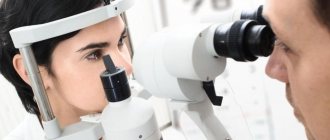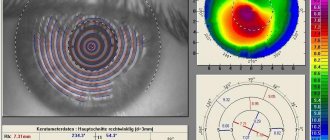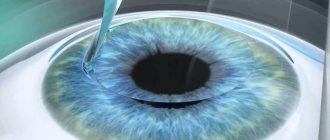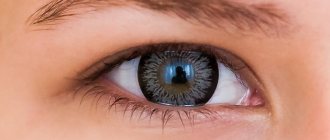In patients with farsightedness, there is a decrease in the optical power of the eyeball, and the focus of the rays is not in the plane of the retina, but behind it. Laser correction of farsightedness uses similar techniques as those used to correct myopia, but such operations are performed much less frequently. This is due to the fact that in the case of hypermetropia, the ophthalmologist’s task is not simply to change the shape of the cornea, but also to make it more curved. This is quite difficult compared to the flattening required in cases of myopia.
In this regard, traditional LASIK, used to correct refractive errors, can be used for small degrees of farsightedness. Also, for hypermetropia, other interventions can be performed, in particular, thermal keratoplasty, including conductive keratoplasty. However, all these interventions are potentially dangerous, as they can cause scar formation on the cornea.
Another method of surgical treatment of farsightedness is the implantation of an intraocular lens, and the lens can also replace the patient’s own lens. This technique is mainly used for high degrees of farsightedness. Due to the fact that the artificial lens cannot change its curvature, IOL implantation is ideal in elderly patients. This is due to the fact that the lens itself in elderly patients has lost its ability to accommodate.
Farsightedness: what is it?
Hypermetropia is the medical name for farsightedness, that is, a vision condition in which the human eye clearly sees objects located in the distance, but practically does not perceive objects located close.
As you know, the image must fall on the retina, only then will a person have excellent vision; with farsightedness, the image falls behind the retina, and that’s why there are problems. It is the visual impairment in question that is considered the most inconvenient, because the person will have difficulty seeing close up, and will not be able to clearly see objects in the distance.
An interesting fact is that almost all newborns are born farsighted, and only as the eyeball grows over the course of 5-7 years does vision return to normal. But 30% of children remain farsighted for various reasons. In adults, it develops starting at the age of 45 and progresses over the years.
That is, the disease is mainly limited to children and the elderly. According to statistics, 10% of the population is diagnosed with the problem in question.
Types of farsightedness
Based on the magnitude of the deviation from the norm, there are 3 types of farsightedness:
- weak degree, less than 2.0 diopters;
- medium degree, less than 4.0 diopters;
- high degree, more than 4.0 diopters.
A strong degree significantly reduces a person’s quality of life: it makes reading and writing difficult; interferes with computer work. In older people, vision, both near and far, is significantly affected. A high degree can lead to the development of a serious disease - glaucoma or cataracts.
Low degree of farsightedness is characterized by the fact that the eyes cope with their task with the help of accommodation.
For each degree of pathology, doctors have developed treatment methods. But it’s worth making a reservation right away - most often the problem is diagnosed already at an advanced stage, which is facilitated by people turning to specialists later. Therefore, ophthalmologists immediately prescribe radical treatment methods, without stopping at gymnastics or special exercises.
Prevention of farsightedness
Prevention of farsightedness is, first of all, compliance with the rules of visual hygiene, which include:
- use of sufficient and uniform desktop lighting;
- maintaining the correct mode of visual work;
- performing special visual gymnastics exercises.
You can learn more about how to maintain the health of your eyes, and also, if necessary, receive treatment recommendations by consulting an ophthalmologist and undergoing a thorough vision diagnosis using high-precision computerized equipment.
Reasons for the development of farsightedness
The cause of abnormal eye refraction is most often the small size of the eyeball along the anteroposterior axis. That is why farsightedness in newborns is a natural physiological phenomenon, which in most cases goes away on its own with age.
Another possible cause of farsightedness is a violation of the accommodation of the lens, its inability to correctly change the curvature. The violation leads to another type of disease - age-related farsightedness. The older a person is, the worse the accommodative capabilities of his eyes are, the more blurry images of nearby objects become.
The ciliary muscle is in constant tension, which allows a person to see all objects at close or far distances equally. But by the age of 45, the ciliary muscle simply gets tired, it is not able to remain in constant tension - all the symptoms of the disorder in question are fully manifested.
Clinical manifestations and diagnosis
To make an accurate diagnosis, the following research methods are used:
- determination of vision using tables;
- tonometry - determination of intraocular pressure;
- computer refractometry;
- ophthalmoscopy - examination of the fundus of the eye;
- gonioscopy - examination of the anterior transparent membranes;
- skiascopy - study of refraction;
- CTG, ultrasound of the eye;
- perimetry - determination of visual fields.
These are the main research methods, and today there are many of them, including even an ECG of the eye.
Symptoms of the disorder are always pronounced: the eyes quickly get tired if they are forced to work at a close distance from objects; recurrent headaches associated with eye strain and localized in the frontal or temporal part of the head; decreased visual acuity near, for example, to read a newspaper, a person is forced to move it further away.
A person with farsightedness may have impaired near vision, but it may also be that the person has poor vision both near and far. Often this disorder is combined with astigmatism, then there are complaints of doubling of objects and distortion of their shapes or sizes.
Preparing for surgery
In order for laser treatment of farsightedness to bring the expected effect, it is necessary to undergo a preliminary diagnostic examination, based on the results of which a conclusion will be made about the possibility of laser vision correction and the choice of technique will be made: PRK, LASIK or Lepto-LASIK.
A comprehensive diagnostic examination includes an assessment of the parameters of the visual system:
- determining the degree of hyperopia, checking for the presence of other refractive errors;
- obtaining a map, shape and value of the radius of curvature of the cornea surface, measuring its thickness;
- measurement of intraocular pressure;
- examination of the anterior segment of the eye and fundus.
Diagnostics are carried out in all branches in Yaroslavl, Vologda, Cherepovets and usually take from 1.5 to 2 hours.
What to choose: glasses or contacts
Despite the fairly high-quality level of modern medicine, glasses still remain unrivaled. They are prescribed to both adults and children to change the refractive power and put the focus in place, that is, on the retina.
This makes it possible for farsighted people to read, work, watch TV, and do other visual work close up, including at home, without straining their eyesight or tiring their eyes, and also see the world without distortion.
If hypermetropia is detected at an early age, glasses have a good corrective effect and by adolescence they can stabilize visual functions.
Treatment of farsightedness also involves wearing contact lenses. Today this technique ranks second in the correction of vision defects. Their purpose is the same as glasses. Only they are more convenient, especially for adults, and are not so noticeable to others; sometimes people, often teenagers, are embarrassed to wear glasses.
Contact lenses are practically not prescribed to young children, since wearing them causes difficulties for them.
It is important to note that glasses and contact lenses are not a treatment, but a means of correcting the visual ability of the eyes. They will not be able to completely cure farsightedness, but they will help stabilize vision and maintain it at an optimal level for a person.
Phakic lens implantation
Phakic lens implantation (IOL) involves placing an additional diverging (“positive”) lens directly onto the lens, which focuses light rays entering the eye onto the retina. Usually, phakic lens implantation is carried out at a young age and with large degrees of hypermetropia, which cannot be corrected by excimer laser vision correction. The IOL is implanted into the eye cavity through a puncture, without suturing. The biocompatibility of the lens material minimizes the risk of complications. The operation and postoperative period are painless, vision improves within a few hours after the intervention. The advantages of this operation include, among other things, the possibility of removing the lens, that is, returning the eye to the preoperative state.
If there is opacification in the lens due to hypermetropia, the lens is replaced for refractive purposes. This operation is similar to that performed for cataracts. Currently, when carrying out such an intervention, the method of phacoemulsification, or crushing the lens using ultrasound, is used. The natural lens is removed through a 2-3 mm puncture, and a soft artificial lens is implanted in its place, designed in such a way that the patient no longer needs distance correction. And recently, a number of large manufacturers have developed and are introducing multifocal artificial lenses, which allow one to see well not only near or far, but to combine sufficiently high vision for both near and far. This happens due to the fact that each such IOL has several focal lengths. True, quite often the patient needs to get used to such a correction.
The choice of tactics for surgical treatment of farsightedness is strictly individual and is determined based on the results of a complete ophthalmological examination. Since refractive surgery is the method of choice, the decision to undergo correction is made by you. We will help you find your way - recommendations depend on your age, general health, existing or pre-existing eye problems, your glasses or contact lenses, lifestyle, profession, work goals and the results you expect from the operation.
Treatment of farsightedness – modern methods of correction
Age-related farsightedness is a natural human condition. It cannot be prevented, but you can avoid the consequences of age-related farsightedness: blurred vision, headaches, eye strain. To do this, you need to start correcting farsightedness in a timely manner using modern correction methods.
Today it is successfully treated using high-tech laser operations on the lens of the eye and the cornea.
Laser correction for farsightedness is considered a proven, safest method. It is used in the following cases: the patient’s age ranges from 18-50 years; farsightedness does not exceed +5 diopters; when combined with astigmatism +3 diopters.
Laser vision correction for farsightedness makes it possible to carry out intervention taking into account the characteristics of the retina, which leads to maximum results. If there are no contraindications to laser correction, doctors consider it the best option for vision correction for diagnosed farsightedness.
Microsurgical operations – replacement of transparent lenses. During surgery, doctors remove the lens and place an artificial intraocular lens in its place. Such operations are performed if the patient is diagnosed with a severe degree of farsightedness and/or there are contraindications to laser correction.
If there is an urgent need for a surgical method, then modern ophthalmological technologies and the experienced hands of a surgeon come to the rescue.
The most common treatments for presbyopia are:
- vision correction using laser;
- Lensectomy - lens replacement;
- use of an implant - phakic lenses;
- performing radial keratotomy.
Implantation of phakic lenses. This correction is carried out only in young patients, when the body is still able to fight the problem on its own. The method has not been studied enough, for example, doctors do not know what will happen to these phakic lenses in 10-15 years.
Hardware technique. These include: ultrasound therapy; vacuum massage; glasses - massagers; electrocoagulation; photostimulation. Hardware treatment is very effective in combination with the above methods, as well as when they are contraindicated.
Gymnastics for the eyes. In addition to the above interventions, farsightedness is corrected with special exercises. There are several sets of such exercises, let’s look at some exercises:
- Exercise 1. You should turn your head to the right and left. It is necessary to observe the correct execution of turns - the head and neck must move simultaneously, while the gaze moves along with the neck and head, that is, you need to look strictly in front of you all the time. You should not strain your muscles while making turns; the speed should be slow and the movement should be smooth.
- Exercise 2. To perform this you will need the following: focus on the left point and lead your gaze, turning your head and neck to the next point, then move in the opposite direction. In this case, the gaze should literally slide along the line. You need to perform such turns until you get the feeling that the line with the dot is moving in the direction opposite to your view.
- Exercise 3. Read any text every day for 10-15 minutes, the object should be located at a distance of 20-30 cm from the eyes. The lighting during this exercise should not be bright; it is dim light that will give a positive effect during such reading, because it is possible to achieve complete relaxation of the organ of vision.
- Exercise 4. Take a table to determine the level of visual acuity, hang it at a distance of 30 cm from the face. Take in your hand a manual table or any text that has wide white stripes between the lines.
How to do it: you need to focus your gaze on the letters of the table for 20 seconds, trying to recognize them, then your gaze is transferred to the manual table - it should slide along the white stripes between the text. When glancing over the white stripes, you need to blink often, but you cannot close your eyes.
In order to cure pathology, an essential condition is required - regularity. It is important to remember that the first signs of farsightedness are a reason to visit a specialist.
Symptoms of farsightedness
The main symptom of presbyopia is the inability to clearly see objects located at close range. If you have to move your hand farther away to read or use your cell phone, this may indicate farsightedness. With hypermetropia, there is also a problem with “distant” vision. In addition, hypermetropia and presbyopia are often accompanied by the following symptoms:
- Reduced image contrast (typical of age-related farsightedness);
- Headache and increased fatigue during prolonged work at close distances, for example, when reading or writing;
- Painful sensations in the eyes, often manifesting themselves as a burning sensation;
- Increased intraocular pressure;
- A feeling of “blurry” of the image up close, regardless of the time of day and the degree of eye fatigue.
Laser vision correction for farsightedness
Laser correction of hypermetropia is by far the most effective method that quickly eliminates the problem and provides a long-lasting, almost permanent effect. The method is based on the properties of the laser to model eye lenses, give them the desired shape and curvature, as well as their seamless laser fixation.
Laser correction is permitted immediately when the growth of the eyeball is completed, starting from the age of 16-18 years. The age limit is determined individually, depending on the state of health and the eye, but does not exceed 60 years. At older ages, laser cataract surgery is performed.
Laser correction is indicated for people who are intolerant of optical correction devices or who are unable to wear them due to their profession. And also for those who simply want to live with good vision. Today, surgery to correct farsightedness is carried out using three main technologies:
- LASIK - laser keratomileusis. A flap is formed from the cornea, which is moved to the side for laser exposure, and then returned to its place. Vision returns to normal in about a week.
- REIC - refractive-corrective excimer laser intrastromal keratectomy. The operation is an advanced LASIK. The corneal flap is placed in a special way, which makes it possible to achieve high visual acuity even in difficult situations. Normalization of vision occurs in about two days.
- LASEK - laser subepithelial keratectomy. A layer of the cornea is separated in the form of a flap and, after laser treatment of the epithelium, it is returned to its place. After the procedure, the eye is protected with a soft contact lens. The epithelium is completely restored within a few hours. The eyes are operated on separately with an interval of 7 days. Vision returns to normal after three weeks.
Laser correction changes the refraction of the eyes. Therefore, after it is carried out, additional means of improving visual acuity are not required. The operation involves applying a laser to the surface of the cornea, while maintaining its transparency and shine. The procedure takes place without pain, discomfort, or blood. Does not require special recovery time.
Progress of the operation
- The operation is usually performed on both eyes at once. Before the operation, anesthetic drops are instilled. No general anesthesia is required.
- The patient is placed on the operating table, the skin around the eyes is treated with a special germ-cleaning solution, and covered with a sterile delimiting bandage. Painkiller drops are instilled once again. Next, the following stages of the operation are carried out:
- To provide access to the middle layers of the cornea, using a special microkeratome device, a flap (“lid”) is cut out from the surface layers of the cornea and turned to the side.
- To achieve optimal results in forming corneal flaps of the required size, a computer method is used to calculate the operating parameters of the device.
- Then the laser evaporates the middle layers of the cornea at its periphery, changing the curvature.
- At the end of the operation, the “lid” is placed in its original place. The flap is fixed without suturing, due to the adhesive properties of the cornea's own collagen.
The undoubted advantages of eliminating farsightedness using a laser are: the absence of significant pain in the postoperative period; minimal recovery period for the eyes; no contraindications for simultaneous surgery on both eyes; preservation of the natural structure of the cornea.
In recent years, laser treatment of farsightedness has become the most effective, safe and predictable method of treating hyperopia. Which technique to choose in a particular case is decided by the attending physician, taking into account the individual characteristics of the patient.
Implants for correction
The capabilities of modern ophthalmic surgery make it possible to remove a defective lens and install in its place a high-quality lens that will refract light and change curvature under the action of muscles.
There are two types of such lenses:
- Multifocal - performs the functions of a lens and normalizes vision;
- Accommodating - replaces the lens and bends under the action of the eye muscles.
In most cases, the lens is placed behind the iris in front of the lens, which helps in proper focusing.
The selection of treatment method occurs separately for each specific case. Often in older people, the transparency of the lens is so severe that it requires complete replacement.
An additional advantage of installing an artificial lens is that it completely eliminates the possibility of cataracts, which in recent years has become an extremely common eye disease in the elderly.
Removal of the clear lens of the eye with implantation of an artificial lens
Clear lens removal (CLR) differs from the vision correction methods described above in that the operation is performed not on the cornea, but on the lens. Instead of reshaping the cornea, the lens is removed and replaced with an artificial eye lens.
The operation is the same as cataract removal, only the clear lens is removed rather than the cloudy one. Like other refractive surgeries, clear lens removal is often performed on an outpatient basis through a small incision. The lens is removed using ultrasound (phacoemulsification). Instead, an intraocular lens (IOL) of the required optical power is implanted. There are no stitches. Vision is usually restored within 24 hours.
UPC is used to correct hypermetropia of any degree. The method is most suitable for patients over 40 years of age, because at this age the ability of accommodation begins to be impaired in most people.
Results of laser correction of presbyopia
Laser correction has such advantages as relative safety, minimum complications, absence of scars, stable refraction, painlessness, and prompt restoration of vision. The only drawback is that the correction of hypermetropia is no more than 6 D. Higher degrees are corrected using FCL implantation.
After the intervention, the first hours may include discomfort, lacrimation, burning, and photophobia. This goes away in about six hours. The first day you should not touch the operated eye. You need to take antibiotics for a week and artificial tears for a month. You can't drink alcohol. For the first two weeks, it is not advisable to communicate with people who have colds, get hypothermic, use cosmetics, or visit saunas, steam baths, or swimming pools.
For the first two weeks, you should not rub or press on your eyes; you need to wash your face carefully. It is recommended to limit physical activity to persons who have undergone laser photocoagulation of the retina. The period of restriction is determined by a specialist. Visual acuity is restored after two weeks.
In case of redness of the eyes, discomfort or decreased vision, you should immediately contact the clinic where the operation was performed.
Benefits of laser correction of hypermetropia
No one needs to be convinced that laser vision correction has advantages over glasses or contact lenses. This is primarily convenience and long-lasting results, allowing a person to forget about eye problems.
In addition, laser correction:
- painless;
- has virtually no contraindications;
- has no complications;
- does not require hospitalization;
- short in time;
- quickly restores vision;
- durable.
Treatment of farsightedness using modern laser correction is the optimal choice for people of all ages, restoring visual acuity.
Cost of laser surgeries in Moscow clinics
Treatment of farsightedness is carried out using laser technologies in an innovative version, there are several of them, and the most optimal method for each patient is selected for him. This will affect the cost of treatment.
Below you can learn more about the cost of various methods for eliminating farsightedness:
- LASIK - 26,000 rub.
- Photorefractive keratectomy - RUB 25,000.
- Epi LASIK - RUB 30,000.
- Super LASIK - RUB 39,000.
- Femto Lasik - RUB 51,000.
- Femto Super Lasik - 60,000 rubles.
The cost of the operation is indicated for 1 eye.
Follow-up appointments with an ophthalmologist and all subsequent examinations are included in the price.
Things to remember
People quite often try to attribute the appearance of the first visual problems to fatigue or age, greatly risking their eye health. After all, at the age of 50, the body is already quite worn out and becomes extremely vulnerable to various kinds of diseases. Therefore, deterioration of vision is often not a symptom of presbyopia, but a manifestation of more serious problems - cataracts, glaucoma, retinal dystrophy or one of the signs of diabetes. That is why people of mature age must make it a rule to regularly visit an ophthalmologist and therapist, and devote enough time to medical examinations and tests.
It is also important to choose the correct glasses correctly. Indeed, when making them, specialists, in addition to diopter, take into account many other parameters that seriously affect the quality of vision. Therefore, glasses should be purchased only in specialized optical stores, and not on market displays, and only after a comprehensive examination by an ophthalmologist.
Prevention
Fresh air, an active lifestyle, proper nutrition are the best prevention of eye diseases.
Eye exercises that are useful for farsightedness include circular movements of the eyes clockwise and in the opposite direction, movements to the right - left, up - down, frequent squeezing and unclenching of the eyes, looking at the tip of the nose and back.
It is useful to massage closed eyes with light pressure, kneading and vibrating movements.
The causes of the disease may lie in improper lighting, which should be neither dark nor bright, but comfortable for the eyes. Improper lighting leads to tension in the eye muscles and causes fatigue.
Farsightedness may be a consequence of frequent reading in transport or in a lying position. This leads to rapid eye fatigue, as there is a continuous process of adjusting to the book, during which the accommodation apparatus suffers first of all. When constantly reading in such positions, a spasm of accommodation is possible.
Prevention of the disease is more effective if farsightedness is detected in the early stages.










